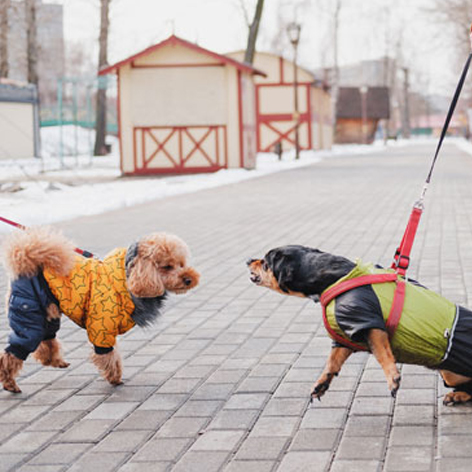Barking at other dogs is a common behavior that can be challenging for pet owners. Whether it’s during walks, at the park, or even in your own garden, excessive barking can strain your relationship with your dog and create tension in public spaces. At the Association of Pet Dog Trainers Ireland (APDT Ireland), we believe that with the right approach, you can help your dog stay calm and confident around other dogs. Here’s a guide to understanding and managing this behavior.
1. Why Do Dogs Bark at Other Dogs?
Barking is a natural form of communication for dogs, but when it’s directed at other dogs, it can stem from various triggers:
- Excitement or Playfulness: Some dogs bark because they’re eager to greet or play with another dog.
- Fear or Anxiety: A dog may bark to create distance from another dog they perceive as a threat.
- Frustration: Leash restrictions or barriers (like fences) can lead to frustration, prompting barking.
- Territorial Behavior: Dogs may bark to protect their space, such as their home or yard.
- Lack of Socialization: Limited exposure to other dogs can make them reactive or unsure.
Understanding the root cause of your dog’s barking is the first step to addressing it. Observing their body language—such as a stiff posture, raised hackles, or a wagging tail—can provide clues about their emotional state.


2. Steps to Manage Barking at Other Dogs
Here are practical, positive training techniques to help your dog stay calm around other dogs:
1. Identify Triggers and Manage Exposure
- Pay attention to when and where your dog barks. Is it only on-leash? At a specific distance? With certain types of dogs?
- Start by keeping your dog below their “threshold”—the point where they start reacting. For example, if they bark at dogs 5 meters away, begin training at 10 meters, where they’re calm.
- Use a leash and maintain a safe distance during walks to prevent overwhelming your dog.
2. Use Positive Reinforcement
- Reward your dog for calm behavior around other dogs. Use high-value treats like small pieces of chicken or cheese to capture their attention.
- When your dog sees another dog and remains calm, mark the moment with a word like “Yes!” and give a treat. This teaches them that seeing another dog leads to good things.
- Gradually decrease the distance between your dog and others, rewarding calm behavior at each step.
3. Teach an Alternative Behavior
- Train your dog to focus on you instead of barking. Commands like “Look at me” or “Sit” can redirect their attention.
- Practice these commands in low-distraction environments first, then gradually introduce them in the presence of other dogs.
- For example, when another dog appears, ask for a “Sit” and reward your dog for complying.
4. Desensitization and Counter-Conditioning
- Desensitization involves exposing your dog to other dogs at a distance they can handle, gradually reducing that distance over time.
- Counter-conditioning pairs the sight of another dog with something positive, like treats or praise, to change your dog’s emotional response.
- Work with a professional trainer to ensure this process is done correctly and at the right pace.
5. Improve Socialization (If Appropriate)
- If your dog’s barking stems from under-socialization, controlled introductions to other dogs can help.
- Arrange calm, one-on-one meetups with well-mannered dogs in a neutral space, ensuring both dogs are comfortable.
- Avoid overwhelming situations like busy dog parks until your dog builds confidence.
6. Exercise and Mental Stimulation
- A tired dog is often a calmer dog. Ensure your dog gets enough physical exercise through walks, play, or activities like fetch.
- Mental stimulation, such as puzzle toys or training sessions, can reduce frustration and excess energy that may contribute to barking.
7. Seek Professional Help
Avoid punishment-based methods, as these can increase fear or anxiety, worsening the behavior.
If barking persists or escalates, consult a certified dog trainer or behaviorist. APDT Ireland members are trained in science-based, positive reinforcement methods and can create a tailored plan for your dog.
3. When to Seek Veterinary Advice
In some cases, barking may be linked to underlying medical issues, such as pain or anxiety disorders. If your dog’s behavior changes suddenly or seems unusually intense, consult your veterinarian to rule out health concerns.
Tips for Success
- Stay Calm: Your dog picks up on your emotions. Stay relaxed and confident during encounters with other dogs.
- Be Patient: Behavior change takes time. Celebrate small improvements and avoid rushing the process.
- Use Proper Equipment: A well-fitted harness or head collar can give you better control during walks, reducing pulling and barking.
- Avoid Triggers When Possible: If your dog isn’t ready to handle certain situations, like crowded parks, choose quieter routes for walks.
Addressing your dog’s barking is not just about stopping the noise—it’s about helping them feel secure and confident in their environment. By using positive, reward-based training, you’re strengthening your bond and setting your dog up for success.
At APDT Ireland, we’re committed to supporting dog owners with kind, effective training methods. Visit our website to find a certified trainer near you or to learn more about our workshops and resources. Together, we can help your dog navigate the world with calm and confidence.
